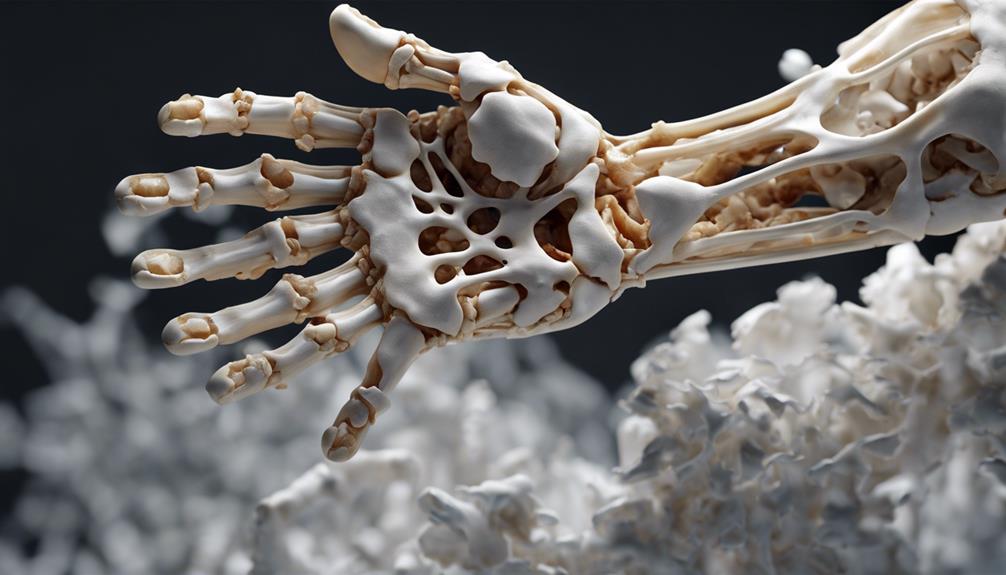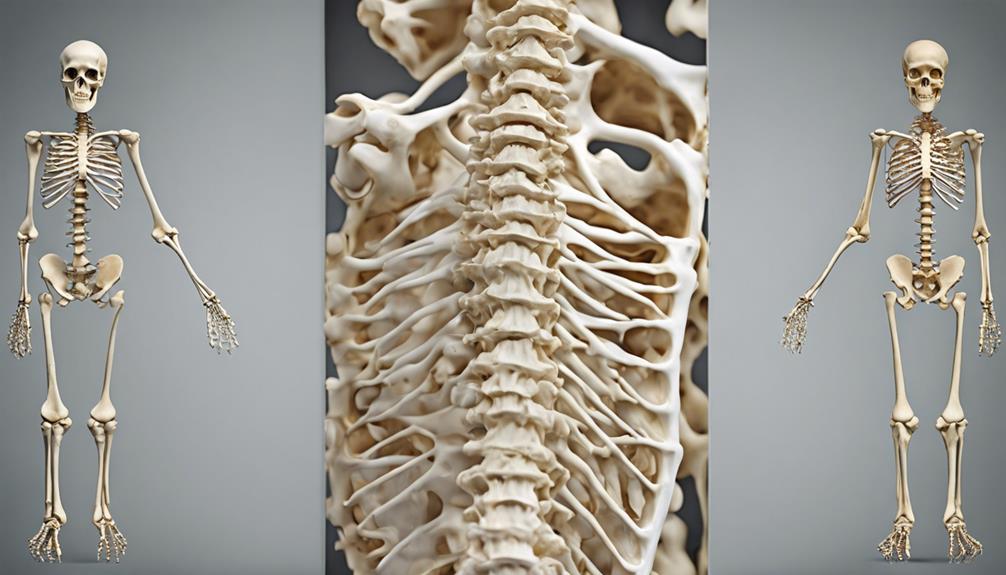We approach Osteoporosis Unspecified ICD-10 with meticulous care and precision. Recognizing the intricacies of this code is essential for precise medical records and billing purposes.
However, the complexity of osteoporosis extends beyond mere coding. Stay tuned to explore the intricate web of diagnosis criteria, treatment options, and management strategies that intertwine within the realm of osteoporosis care.
Overview of Osteoporosis Unspecified ICD-10
When assigning codes for osteoporosis cases with unspecified type, healthcare professionals commonly utilize the ICD-10 code M81.9. This specific code, M81.9, serves a crucial role in the accurate diagnosis, coding, and billing of osteoporosis cases where the type isn't specified.
Healthcare providers rely on M81.9 to indicate the presence of osteoporosis without the need to further specify the exact type, streamlining the documentation process while maintaining accuracy. The use of M81.9 is particularly important in cases where bone density scans or other tests don't reveal the specific type of osteoporosis present.
Coding Guidelines for Osteoporosis ICD-10

Shifting focus to the vital aspect of coding guidelines for osteoporosis in the ICD-10 system, it's imperative to understand the proper sequencing of underlying conditions and manifestations to ensure accurate documentation and billing practices.
When assigning an ICD-10 code for osteoporosis, such as M81.9 for unspecified osteoporosis without current pathological fracture, accuracy is paramount. Proper sequencing involves capturing the primary diagnosis of osteoporosis first, followed by any related manifestations. It's crucial to use additional codes for these manifestations to provide a comprehensive picture of the patient's condition.
By adhering to accurate coding practices, healthcare providers can facilitate effective treatment and streamlined billing processes. Ensuring the correct ICD-10 coding not only aids in individual patient care but also contributes to population health management by enabling better tracking and managing of osteoporosis at a broader level.
Stay diligent in applying the coding guidelines to guarantee precise and thorough documentation for optimal patient outcomes.
Diagnosis Criteria for Osteoporosis Unspecified
The diagnosis criteria for osteoporosis unspecified encompass the classification of bone health conditions using the ICD-10 code M81.9. This code is crucial for diagnosing and billing adult patients aged 15 to 124 years who do not have a current pathological fracture. By accurately applying the ICD-10 code M81.9, healthcare providers can effectively classify and treat individuals with varying degrees of osteoporosis. The table below summarizes key points related to the diagnosis and management of osteoporosis unspecified using the ICD-10 code M81.9:
| Criteria | Details |
|---|---|
| Age Range | 15 to 124 years |
| Code Classification | ICD-10 code M81.9 |
| Diagnostic Importance | Essential for accurate diagnosis, billing, and providing preventive measures for osteoporosis |
Accurate diagnosis through proper ICD-10 coding not only aids in appropriate treatment but also enables the implementation of preventive measures to manage osteoporosis effectively.
Treatment Options for ICD-10 Osteoporosis

Treatment strategies for ICD-10 unspecified osteoporosis encompass a range of options, including lifestyle modifications, medications, bone density monitoring, fall prevention, and surgical interventions for severe cases.
Lifestyle modifications such as weight-bearing exercises and a calcium-rich diet play a crucial role in managing osteoporosis.
Medications like bisphosphonates, denosumab, and hormone therapy are commonly prescribed to help strengthen bones and reduce fracture risk.
Regular monitoring of bone mineral density through DEXA scans is vital to assess the progress of treatment and adjust interventions accordingly.
Fall prevention strategies and safety measures at home, like removing tripping hazards, are essential in preventing fractures in individuals with osteoporosis.
In severe cases where fractures occur, surgical interventions such as vertebroplasty or kyphoplasty may be considered to stabilize the spine and relieve pain associated with vertebral compression fractures.
Management Strategies for Osteoporosis ICD-10
Monitoring bone density changes through accurate ICD-10 coding is crucial for evaluating the progression of osteoporosis management. To effectively manage unspecified osteoporosis using ICD-10 code M81.9, healthcare professionals can employ the following strategies:
- Regular Bone Density Monitoring: Utilize ICD-10 coding to track changes in bone density over time, enabling timely interventions to prevent fractures.
- Precise Diagnosis with ICD-10 Codes: Accurately document osteoporosis using specific codes like M81.9 to guide treatment decisions and monitor disease progression.
- Implementing Tailored Treatment Strategies: Utilize ICD-10 codes to tailor treatment plans based on individual patient needs and risk factors, ensuring optimal care.
- Collaborative Approach: Foster collaboration among healthcare providers to ensure a comprehensive management plan that addresses both the bone health and overall well-being of patients with unspecified osteoporosis.
Frequently Asked Questions
What Is the ICD-10 Code for Osteoporosis Type Unspecified?
We use ICD-10 code M81.9 for osteoporosis type unspecified. This code is crucial when the specific type of osteoporosis is unknown.
It allows accurate documentation and classification of cases where the exact nature of osteoporosis remains unclear. Proper use of M81.9 ensures precise diagnosis and appropriate management of unspecified osteoporosis, aiding healthcare providers in delivering targeted care to patients.
What Is the ICD-10 Code for Osteoporosis 2023?
We've got the latest! The ICD-10 code for osteoporosis starting in 2023 is M81.0. This code applies to adults aged 15-124 for billing purposes.
Osteoporosis is a silent threat, especially in elderly women, with risks like age and family history. Accurate coding is crucial for diagnosing and treating this condition effectively.
Stay informed to ensure proper management and tracking of osteoporosis cases in the population.
What Is the ICD-10 Code for M81.9?
The ICD-10 code for M81.9 is used to classify unspecified types of osteoporosis. It ensures accurate documentation when the specific nature of the condition isn't identified.
Healthcare professionals rely on M81.9 to code cases where the type of osteoporosis is unspecified in medical records. This code is crucial for proper classification and management of osteoporosis cases with unspecified details.
What Is the ICD-10 Code for M81 6?
When coding for localized osteoporosis, specifically Lequesne's disease, for a patient with bone loss in specific areas, the ICD-10 code M81.6 is utilized. This code is crucial for accurately documenting and monitoring cases of this condition.
It helps healthcare providers tailor treatment plans for the affected areas and ensures proper billing. By correctly applying M81.6, we can improve patient care and streamline coding processes.
Conclusion
In conclusion, when it comes to managing Osteoporosis Unspecified ICD-10, early detection and proper treatment are key. By following the coding guidelines, diagnosing based on specific criteria, and utilizing appropriate treatment options, we can effectively address this condition.
Remember, 'an ounce of prevention is worth a pound of cure' – taking proactive steps now can help prevent serious complications in the future. Stay informed, stay proactive, and prioritize your bone health.









